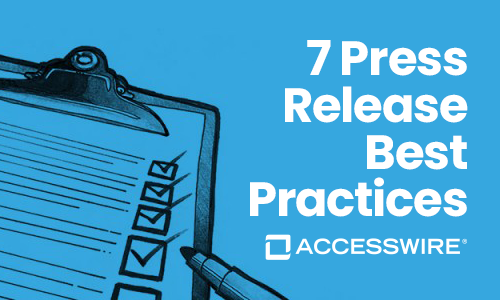What is an AP Press Release Style Format?
An effective public relations strategy is a foundational piece of a business’s success.
It gives companies the stage to communicate with their target audience and establish themselves as credible thought leaders in their respective industries.
In addition to the myriad of marketing strategies available to businesses including social media, email marketing, and pay-per-click advertising to name a few, one of the mainstays and a tried and true method of building brand awareness and driving your business are press releases.
Press releases are a marketing vehicle that’s designed to connect brands with the media and their target audience to deliver news, announce events, or promote company updates.
Using an efficient press release service will give your company the media coverage it needs.
A press release that captures the attention of the media is comprised of two components...
- A newsworthy angle
- Proper press release format
And, in this blog post, we cover the details of how to perfect your press release format with AP Style. You’ll learn:
- What is AP Style?
- What are AP style guidelines?
- AP Style press release tips
What’s a AP Style?
AP Style stands for Associated Press Style and is the gold standard that all news writing is measured. AP Style creates a consistent and uniform structure for news writing, grammar, abbreviations and titles.
What Are AP Style Press Release Guidelines?
The Associated Press is a non-profit news agency that publishes a new Stylebook every other May. This Stylebook provides a set of guidelines that news and media outlets use.
When writing a press release, be sure to follow these basic AP Style guidelines:
Dates
Use numbers for dates and abbreviate months with more than five letters.
Dateline
According to the AP Stylebook, a proper dateline should contain “a city name, entirely in capital letters, followed in most cases by the name of the state, county, or territory where the city is located.”
Some metropolitan areas do not require the state in the dateline:
- ATLANTA
- BOSTON
- CHICAGO
- SAN FRANCISCO
- SAN DIEGO
- WASHINGTON
If a state is required, use the correct AP Style state abbreviation. For example:
- KANSAS CITY, Mo. (Missouri)
- PORTLAND, Ore. (Oregon)
- PORTLAND, Maine
Headings and subheadings
Use title case capitalization.
Font and font size
Use common fonts like Arial or Times New Roman and use these font sizes:
- Headline - 14 pt.
- Subheadline - 13 pt. (italics)
- Body - 12 pt.
Numbers
Be sure to spell out numbers between one and nine. For numbers 10 and up, use numerals.
Spacing
Use only one space after a period.
Serial comma
Don’t use a comma before the last item in a series.
Perspective
Use a third-person perspective (he, she, it, and they) when writing an AP Style-formatted press release. Never use the first person (I or we) or second person (you).
AP Style & Press Release Structure
When writing a press release, always use the inverted pyramid. This format helps you address the most important information at the beginning of your press release.
The inverted pyramid covers the five W’s (who, what, when, where, and why) to help the journalist understand the main points of interest.
Besides the standard press release format, there are other ways to structure your content.
To learn more, read our guide on how to cite a press release and take a look at our example of a press release for an event.
Other Important AP Style Press Release Tips
While having a basic understanding of the general AP Style rules will help you effectively and efficiently share your news, there are other important guidelines to consider.
Let’s explore them in detail below.
Content
Journalists are looking for stories that appeal to their target audience.
That’s why understanding who makes up your target audience is an important first step in crafting a compelling press release.
Think about who this is and how the news within your press release may affect them.
Once you understand your angle, you can effectively write your headline, first paragraph, body, and boilerplate.
How to Write a Press Release Headline
Your press release headline is what can pique a journalist’s interest and encourage them to continue reading.
To make sure your headline is compelling, there are a few suggestions to follow.
- Include specific details – For example, if you're writing about a successful fundraiser, make sure to include the exact amount that was raised.
- Call your reader to action – If your business is using a release to spread the word about an upcoming event, use your headline to encourage action. For example, “Join COMPANY NAME for…”
- Tie in current events – The more your news relates to current events, the more likely a journalist will be to write a story about it.
After your headline, you’ll dive into the first paragraph.
How to Write the First Paragraph
Your opening paragraph is a very important part of your story.
It should give the reader an overview of the main points - who, what, when, where, and why - of your press release.
Subsequently, you should go into greater detail about these topics in the other parts of the release.
How to Write a Press Release Boilerplate
The boilerplate concludes your press release.
It provides the reader with information about your company.
Like the first paragraph, your boilerplate should be short and sweet—typically under 100 words.
An effective boilerplate will include noteworthy details about your business, including:
- Background and history
- Awards and distinctions
- Time in the industry
If you’d like to learn how to write a boilerplate for your brand, check out our blog post for more information!
Structure
Always specify the press release time and date in the top right-hand corner in all caps to make sure your release is distributed when intended.
If your press release is ready to distribute, add FOR IMMEDIATE RELEASE under the release time and date.
If the press release isn’t ready, you can add EMBARGOES FOR RELEASE UNTIL [DATE AND TIME OF RELEASE].
In the upper left-hand side of the document, include your:
- First and last name
- Phone number
- Email address
- Website
From there, center your headline and subheadline.
Left align the body of your text and begin with the dateline to tell readers where and when the story took place.
Include the city and state as well as the date including the month and year.
The text that follows the dateline is referred to as the first paragraph.
It’s here you’ll summarize the main message of the press release including the who, what, and why. Try to keep this section to 60 words or less. If it’s too long, you run the risk of losing your readers’ interest.
If you need help structuring your press release, try one of our press release templates.
How AP Style Press Release Format Benefits Journalists
Formatting your press release in AP style is beneficial to journalists because it’s the writing style used across all news and media publications.
If your press release is already formatted this way:
- Journalists don’t have to worry about reformatting the content
- The information is quick and easy to read
- The key facts are clearly stated
This means that a journalist who receives an AP style format press release is more likely to read the release, which increases its chances of being published as a full news story.
Ensure Your Audience Reach and Press Release Success with ACCESSWIRE
A captivating press release that’s written in proper AP style press release format is sure to garner the attention of journalists, giving your business the opportunity to become wide-reaching news.
But to ensure your press release makes it into the right hands, you’ll need to ensure proper distribution. That’s where we can help.
At ACCESSWIRE, we offer press release distribution services for private companies, public companies, and agencies. With over 15 years of experience in the industry, we understand how to increase your press release exposure, reach your target audience, and grow your business. Connect with us today to get started.
Similar Blog Posts
PRODUCTS
ACCESSWIRE | All Rights Reserved





